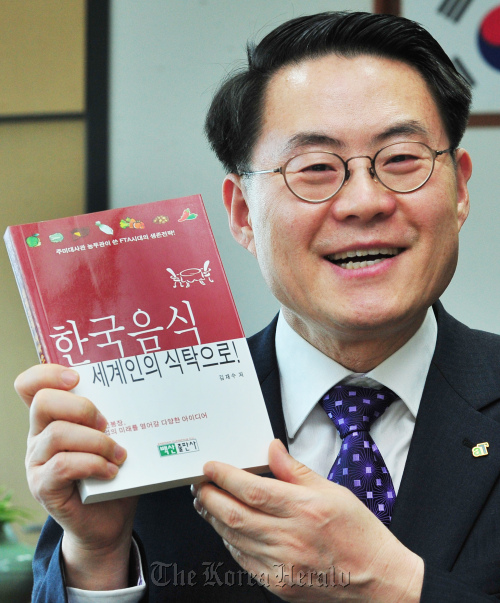Food manufacturers will need to be creative in adapting flavors to local tastes and aesthetics to popularize more Korean cuisine on the international stage, the head of a state-run agriculture trade agency said.
“How we export Korean food now won’t take our food to the American dining table. Food exporters need to brand each dish with a standardized name, twist flavors to fit local taste, and give it a unique brand,” CEO Kim Jae-soo of the Korea Agro-Fisheries & Food Trade Corp. said in a recent interview with The Korea Herald.
 |
Kim Jae-soo, head of Korea Agro-Fisheries & Food Trade Corp, holds a book on food he authored. (Park Hyun-koo/The Korea Herald) |
The veteran food researcher, who has published two books on food exports, said the traditional Korean style of a bowl of rice served with soup and side dishes will never be packaged into an international product. He said the best strategy to meet the government’s goal of boosting food exports by 30 percent this year is to make more of kimchi.
“We cannot possibly compete with the U.S. food processors in terms of production scale and therefore pricing. Food companies need to bet on dishes already famous on the international stage and put effort into marketing.”
Kim picked seasoned laver, or “kim,” as a successful example from last year.
“Seasoned laver has become the fourth most exported processed food last year after it was marketed as a snack, not a side dish that goes with rice in full meals. We need to embrace that eating habits are different elsewhere,” he said.
Efforts to popularize Korean food abroad were initiated by the state-run agency in 2008 when it first launched the “Food in Korea” campaign in 2008. It identified 10 top foods, including kimchi, bulgogi, bibimpap, naengmyeon, samgyetang, chapchae, sinsollo, and three broader categories of confectionery and drinks. While the campaign itself was a success, it also highlighted obstacles in further boosting food exports. aT recognizes that Korea needs to sell more processed items as finger food marketed in standardized Romanization.
The need has become particularly important with the Korea-U.S. free trade agreement which is expected to wipe out at least 12.67 trillion won of local production in the agriculture and livestock industries over the next 15 years, according to government estimates.
Since taking office in October, Kim has made the 30 percent expansion goal to $10 billion a priority. The agency renamed itself from the Korea Agro-Fisheries Trade Corporation, adding “Food” to its title.
While recognizing that a 30 percent export boost is ambitious, Kim said the potential is strong with the growing popularity of Korean culture.
“Look what happened with Hongcho, the raspberry flavored red vinegar in Japan. It was surprisingly a hit because K-pop group Kara modeled for it in Japan. There will be more cases like that especially in China and Japan,” he said.
Kim said the next big project for the agency is acquiring a U.S.-based grain company to secure a stable import of wheat, beans, and corn in the medium-term.
“We formed a consortium with private food manufacturers and logistics firm to take over a grain company in the U.S. Should it work out, aT will be able to help stabilize staple grains at less volatile prices,” Kim said.
The $2.5 million state-project is being carried out by aT Grain, a joint public-private venture in Chicago, with participation from Samsung C&T, STX, and Hanjin Transportation.
By Cynthia J. Kim (
cynthiak@heraldcorp.com)








